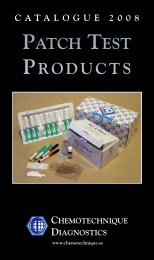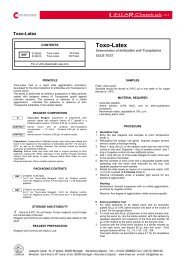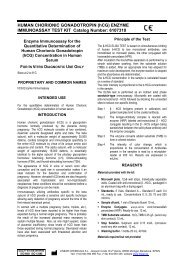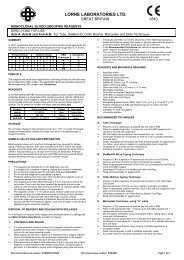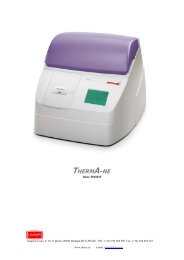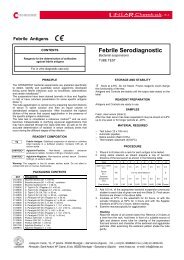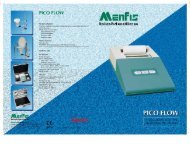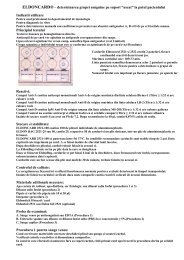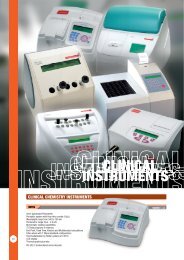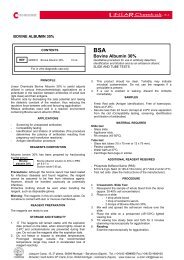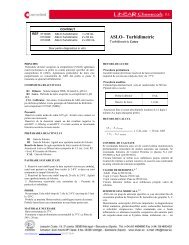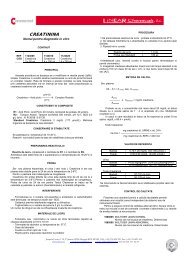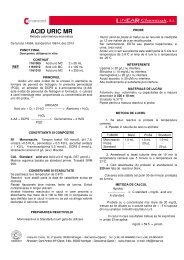LORNE LABORATORIES LTD. - Balmed
LORNE LABORATORIES LTD. - Balmed
LORNE LABORATORIES LTD. - Balmed
Create successful ePaper yourself
Turn your PDF publications into a flip-book with our unique Google optimized e-Paper software.
<strong>LORNE</strong> <strong>LABORATORIES</strong> <strong>LTD</strong>.<br />
GREAT BRITAIN<br />
10 X CONCENTRATED LOW IONIC STRENGTH SOLUTION (LISS)<br />
DIRECTIONS FOR USE<br />
LISS Concentrate: For Specific Serological Studies.<br />
SUMMARY • Glass test tubes (10 x 75 mm or 12 x 75 mm).<br />
• Osmolality reader.<br />
Reducing the ionic strength of a test system increases the rate of red blood cell<br />
• pH meter.<br />
antigen-antibody binding. Low and Messeter in 1974 showed that the use of a<br />
• Phosphate Buffered Saline (PBS): NaCl 0.9%, pH 7.0 ± 0.2 at 22ºC ± 1ºC<br />
low ionic strength solution enhances the rate of antibody uptake in first stage of<br />
• Volumetric beaker.<br />
agglutination, allowing incubation times to be shortened.<br />
• Volumetric pipettes.<br />
• Water bath or dry heat incubator equilibrated to 37ºC ± 2ºC.<br />
PRINCIPLE<br />
When used by the recommended techniques, the solution will reduce the ionicstrength<br />
of a test system, increase the rate of red blood cell antigen-antibody<br />
binding and permits a substantial reduction in incubation time and an increases<br />
in the test sensitivity with many antibody specificities.<br />
REAGENT<br />
Lorne LISS Concentrate is a solution of glycine, phosphate buffer and 0.3 M<br />
sodium chloride. The solution is supplied at a stronger concentration than<br />
needed for serological use. It must be diluted 10 times in deionised water before<br />
being used with all recommended techniques mentioned. For lot reference<br />
number and expiry date see Bottle Label.<br />
DILUTION OF LISS CONCENTRATE<br />
1. Check container of LISS Concentrate for deposits of solutes which if<br />
present should be thoroughly re-dissolved before dilution of concentrate.<br />
2. Accurately dilute 1 volume of Lorne LISS Concentrate with 9 volumes of<br />
good quality distilled or deionised water. The diluted solution should be<br />
measured and be within the following parameters:<br />
• pH: 6.7 ± 0.2<br />
• Conductivity: 3.7 ± 0.3 mS/cm at 22ºC ± 1ºC.<br />
• Osmolality: 295 ± 10 mOsm/Kg<br />
3. LISS “Working Strength” is stable at 18-25ºC for 4 weeks, provided that<br />
contamination is avoided.<br />
4. If stored at 2-8ºC, LISS “Working Strength” should be brought to room<br />
temperature prior to use.<br />
5. Discard solution if it is turbid.<br />
RECOMMENDED TECHNIQUE<br />
STORAGE 1. Wash cells at least twice in PBS and then wash red cells once in working<br />
strength LISS<br />
Do not freeze. Reagent vials should be stored at 15 - 30ºC on receipt. Prolonged<br />
2. Resuspend red cells to 1.5-2.0% in LISS “Working Strength”.<br />
storage at temperatures outside this range may result in accelerated loss of<br />
3. Equal volumes of LISS suspended red cells and serum should be mixed<br />
reagent reactivity. Reagent will remain stable for up to 7 days when subjected to<br />
thoroughly for LISS procedures, e.g. 2 volumes of 1.5-2% cell suspension<br />
temperatures not exceeding 30ºC<br />
and 2 volumes of serum.<br />
SAMPLE COLLECTION AND PREPARATION<br />
Blood samples should be drawn aseptically into EDTA and tested within 48<br />
hours. If EDTA is unavailable, samples drawn into ACD, CPD or CPDA-1 are<br />
acceptable and may be tested up to 35 days form the date of withdrawal. All<br />
blood samples should be washed at least twice with PBS before being tested.<br />
PRECAUTIONS<br />
1. The reagent is intended for in vitro diagnostic use only.<br />
2. If a reagent vial is cracked or leaking, discard the contents immediately.<br />
3. Do not use the reagent past the expiration date (see Vial Label).<br />
4. Protective clothing should be worn when handling the reagents, such as<br />
5. disposable Contact with gloves LISS and together a laboratory with bleach coat. causes accelerated corrosion of<br />
base metals such as copper and iron. This should be borne in mind when<br />
considering the use of bleach for decontaminating plumbing or apparatus<br />
with metal parts, which have also been in contact with LISS.<br />
6. The reagent contains 0.1% sodium azide. Sodium azide may be toxic if<br />
ingested and may react with lead and copper plumbing to form explosive<br />
metal azides. On disposal flush away with large volumes of water.<br />
LIMITATIONS<br />
1. The suspension of red cells in LISS is associated with an accelerated<br />
deterioration in the expression of Fy a , Fy b , s and S antigens and therefore<br />
red cells suspended in LISS should be discarded within 24 hours of their<br />
preparation.<br />
2. Adherence to 1:1 volumetric ratio of cell suspension to serum and thorough<br />
mixing is essential to the integrity of the low ionic test system.<br />
3. For optimum sensitivity, LISS IAT should be incubated for a minimum of 15<br />
minutes at 37ºC.<br />
4. In order to avoid non-specific uptake of autologous complement red cells<br />
should be washed at least twice in NISS before they are finally washed and<br />
resuspended in LISS.<br />
5. Not all antigen-antibody reactions are enhanced by LISS techniques.<br />
DISPOSAL OF REAGENT AND DEALING WITH SPILLAGES<br />
For information on disposal of the reagent and decontamination of a spillage site<br />
see Material Safety Data Sheets, available on request.<br />
CONTROLS AND ADVICE<br />
1. The LISS solution, red cell suspensions and test sera should be at room<br />
temperature prior to use to avoid encountering unwanted positive reactions<br />
due to “cold” antibodies.<br />
2. The use of the reagent and the interpretation of results must be carried out<br />
by properly trained and qualified personnel in accordance with the<br />
requirements of the country where the reagents are in use.<br />
3. The user must determine the suitability of the reagent for use in other<br />
techniques.<br />
REAGENTS AND MATERIALS REQUIRED<br />
• Conductivity meter.<br />
• Distilled or deionised water.<br />
SPECIFIC PERFORMANCE CHARACTERISTICS<br />
1. Prior to release, each lot of Lorne LISS Concentrate, when diluted to<br />
“Working Strength”, has been shown to enhance many antigen-antibody<br />
reactions when used by the Recommended Techniques.<br />
2. The solution complies with the recommendations contained in the latest<br />
issue of the Guidelines for the UK Blood Transfusion Services.<br />
DISCLAIMER<br />
1. The user is responsible for the performance of the reagent by any methods<br />
other than those mentioned in the Recommended Techniques.<br />
2. Any deviations from the Recommended Techniques should be validated<br />
prior to use 10 .<br />
BIBLIOGRAPHY<br />
1. Low B., Messeter L. Antiglobulin test in low ionic strength salt solution for<br />
rapid antibody screening and crossmatching. Vox. Sang. 1974; 26. 53-61.<br />
2. Moore C., Mollison P.L. Use of low ionic strength saline medium in manual<br />
tests for antibody detection. Transfusion 1976; 16. 291-296.<br />
Document reference number: CEPI460 Document issue number: 1/06/2004 Page 1 of 3
3. Wicker B., Wallas C.H. A comparison of low ionic strength saline medium<br />
with routine methods for antibody detection. Transfusion 1976; 16. 469-<br />
472.<br />
4. Voak D., Downie D.M., Darnborough J., Haigh T.J., Fairham S.A. Low ionic<br />
strength media for rapid antibody detection: optimum conditions and quality<br />
control. Med. Lab. Sci. 1980; 37. 107-118.<br />
5. Hiagh T.J., Fairham S.A. Advantages of low ionic strength saline (LISS)<br />
techniques in blood bank management. Med. Lab. Sci. 1980; 37. 119-125.<br />
6. Dynan P.K. Evaluation of commercially available low ionic strength salt<br />
(LISS) solutions. Med. Lab. Sci. 1981; 38. 13-20.<br />
7. Voak D., Downie M., Haigh T.J., Cook N. Improved antiglobulin tests to<br />
detect difficult antibodies: detection of Anti-Kell by LISS. Med. Lab. Sci.<br />
1982; 39. 363-370.<br />
8. Phillips P.K., Bebbington C. The pH, conductivity and osmolality of low<br />
ionic strength solutions used within the U.K. for the antiglobulin test.<br />
Transfusion Medicine 1991; 1. 155-158.<br />
9. Guidelines for the Blood Transfusion Service in the United Kingdom.<br />
H.M.S.O. Current Edition.<br />
10. British Committee for Standards in Haematology, Blood Transfusion Task<br />
Force. Recommendations for evaluation, validation and implementation of<br />
new techniques for blood grouping, antibody screening and cross<br />
matching. Transfusion Medicine, 1995, 5, 145-150.<br />
AVAILABLE REAGENT SIZES<br />
Vial Size Catalogue Number<br />
500 ml 460500<br />
2500 ml 460025<br />
For the availability of other sizes, please contact:<br />
Lorne Laboratories Limited<br />
Unit 7 Tavistock Estate<br />
Ruscombe Business Park<br />
Ruscombe Lane<br />
Twyford<br />
Reading RG10 9NJ<br />
England<br />
Tel: +44 (0) 118 934 2400<br />
Fax: +44 (0) 118 934 2788<br />
E-mail: info@lornelabs.com<br />
TABLE OF SYMBOLS<br />
Document reference number: CEPI460 Document issue number: 1/06/2004 Page 2 of 3



